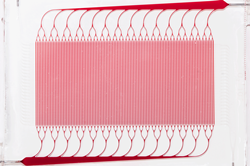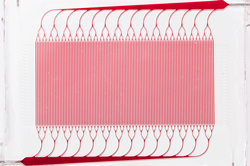
By mimicking blood flow patterns in the human body, engineers improve the safety and efficacy of artificial lungs, a potential benefit to critical care patients and combat casualties.
“Here we report on development and demonstration of the first microfluidic respiratory assist device at a clinical scale, demonstrating efficient oxygen transfer at blood flow rates of 750 milliliters per minute, the highest ever reported for a microfluidic device,” said Draper and AREVA.
CAMBRIDGE, Mass. (PRWEB)
May 30, 2023
A mechanical device for oxygenating blood outside the human body, essentially functioning as an artificial lung, is taking a leap forward fifty years after its debut. The original device in clinical use today, called ECMO, which stands for extracorporeal membrane oxygenation, has been reimagined by bioengineers at Draper who took their cues from the way the human body oxygenates blood in the branching circulatory system.
The results, published in the journal Advanced Science, demonstrate a new configuration of an ECMO device that delivers oxygen and removes carbon dioxide in blood that travels through branching microchannels. The study, by researchers at Draper and The Autonomous Reanimation and Evacuation (AREVA) research program and innovation institute of the Geneva Foundation, is a “key step toward translation of this technology to the clinic for treatment of a range of lung diseases,” said Jeff Borenstein, Ph.D., a laboratory fellow at Draper. Critical care patients such as premature infants, transplant and pneumonia patients and others suffering respiratory failure and related conditions may benefit, he added.
ECMO technology was developed in the late 1960s, and its main purpose was to serve as a temporary bypass machine to support gas exchange for patients undergoing heart surgery. The central functional unit of current ECMO systems are a hollow fiber membrane oxygenator (HFMO), a device designed to add oxygen and remove carbon dioxide from the blood by passing it over a fiber bundle in a specially designed container. Since its inception, the safety and availability of ECMO has been limited by the complexity of the blood circuit, hemocompatibility of the oxygenator and circuit components and complications such as clotting, bleeding and inflammatory responses.
While only the largest and most specialized medical centers currently offer ECMO, the demand for ECMO spiked during the pandemic, since the conventional means for respiratory support— mechanical ventilation—resulted in poor patient outcomes and high mortality. A safer and simpler-to-use device could bring the life-saving power of heart and lung bypass to civilian patients when ICU beds are limited—and to military casualties on the battlefield. However, current ECMO based on HFMO technology requires a large team of highly specialized personnel to administer the treatment and deal with frequent complications.
Draper addressed ECMO’s challenges by developing a three-dimensional branching network of blood channels that mimic key features of the human body’s microcirculation, an approach that is not possible with conventional HFMO cartridge technology. They focused on scalable operation at clinically relevant flow rates and stable, long-term performance. They used microfluidic technology, a specialty at Draper, to control for flow behavior, fluidic resistance, shear stresses and uniform distribution across the microfluidic device.
“Here we report on development and demonstration of the first microfluidic respiratory assist device at a clinical scale, demonstrating efficient oxygen transfer at blood flow rates of 750 milliliters per minute, the highest ever reported for a microfluidic device,” the authors said. “One of the most promising routes of innovation in ECMO entails the use of microfluidics technology for the design and construction of the oxygenator, with the potential to replace the HFMO with a branching network of microchannels that recapitulates key aspects of the lung vasculature.”
Brett Isenberg, a co-author of the paper and a principal member of the technical staff, said, “One of the most common criticisms of the microfluidic approach is that it will never be capable of operating at clinically relevant flow rates. However, with this study, we have taken the first major step towards demonstrating the viability of microfluidic oxygenators at a scale and duration that is suitable for human patients.”
The research is a collaboration between Draper and the AREVA Research Institute in San Antonio, Texas. “AREVA is a pioneer in developing and testing groundbreaking life-saving interventions in critical care and, specifically, for life-threatening injuries leading to lung and multiorgan failure such as seen in combat casualties and severely injured civilians,” said Andriy Batchinsky MD, founding director of AREVA and co-principal investigator in charge of clinically-relevant testing of the microfluidic oxygenator that Draper developed.
“While ECMO has been around for a while, it is not widely adopted in combat scenarios or in the clinical environment,” says Dr. Teryn Roberts, Dr. Batchinsky’s colleague and research partner, and a principal investigator at AREVA and co-investigator on this study overseeing biocompatibility assessment. “Draper’s innovations in solutions for the warfighter, including ECMO, was a natural fit for our work at AREVA where we specifically focus on development and testing of novel biocompatible materials for extracorporeal life support (ECLS), as well as the effects of ECLS on coagulopathy and endothelial damage following trauma.”
Initially launched with internal funding, Draper’s biomimetic ECMO device advanced from lab to bench scale with funding from the National Institutes of Health, Department of Defense and commercial device manufacturers. In 2021, Draper’s advancements received recognition from the American Society for Artificial Internal Organs.
The U.S. Army Medical Research Acquisition Activity, 820 Chandler Street, Fort Detrick MD 21702-5014 is the awarding and administering acquisition office. This work was supported by The Assistant Secretary of Defense for Health Affairs endorsed by the Department of Defense, in the amount of $4,9111,476.00, through the Peer Reviewed Medical Research Program under Award Number W81XWH1910518. Opinions, interpretations, conclusions, and recommendations contained herein are those of the author(s) and are not necessarily endorsed by the Department of Defense. In conducting research using animals, the investigator(s) adhere(s) to the laws of the United States and regulations of the Department of Agriculture.
Visit Draper.com.
Share article on social media or email:

